#pioneer space sim
Explore tagged Tumblr posts
Text
It’s excellent art, they’re nice ships. Hell, everyone can do as they want, I just need to talk about this. So, a few years ago I was really into Pioneer. It’s a fun game, good design, scratches a lot of itches. I wanna talk about why I quit the community and haven’t touched or talked about it since. I'd been bughunting for them for about a year at that point and had found some real interesting doozies; I’m why there’s a limit on objects in a system, I kept crashing the game by how I did my mining. I also found a bug that would cause two space stations to be in the same space. That was kinda cool. So I was rather invested when I noticed some tutorial text that said, “I’m going to manifest my destiny,” or some such. It's in a personal log that I'd just never looked at before. So I popped into the IRC channel (or, more likely, alt-tabbed to it; I idled in there a lot) and suggested, as politely as I could, that a game called Pioneer having a reference to manifest destiny might set, uh, the wrong tone and be upsetting to some players, and they should really consider rephrasing it. The response started with "he's Eastern European, they don't know that phrase there" and ended in him being like "OH I BET YOU HATE THAT WE ONLY HAVE TWO SEXES TOO HUH WELL TOUGH SHIT." Like, I had sure noticed the "hrm, only male/female," but I didn't bring it up because whatever, I assumed it was ignorance, not a deliberate decision, so when he was like "OH I BET YOU HATE THAT TOO" I was like, "I mean, I had noticed it, but I didn't realize until just now it was with intent, so yeah, you could fix that too." And bear in mind this is IRC, I didn't exactly have my pronouns in my nick the way I do in Discord, due to character limits. He just pegged me as someone who'd be upset about the apparently deliberate choice to have only male and female options, and decided to use this as leverage to make me feel angry and sad and upset. Fuck me for picking my battles I guess. And then everyone circled their wagons around him and demanded I apologize. They demanded I apologize for him picking a transphobic fight with me, over me suggesting as politely as I could that a game called Pioneer maybe shouldn't set its tutorial tones by referencing *manifest destiny.* The art guy, don’t remember the spelling, a nice guy whose name kinda is a joke on nose-miner, talked to me in PMs vaguely apologetically and was like, "they've worked with him a long time," and I was like "y'know what just... never mind." and fucked off forever. Nice isn’t always good, I guess. I’m not sure what I’d’ve done differently in his circumstances. You work with someone a long time, and they suddenly spout hate, what you gonna do? I guess quarantine him until you can talk about it? It can be hard to make that stand when you know it’s you or him, and everyone else has already picked him. Maybe nose-miner would do something different now. Maybe not. I’m not unsympathetic, but I haven’t spoken to him since. What’d be the point? What would we have to say to each other anymore? Everyone else can fucking hang for all I care. Looking back, I'm almost certain (a) the writer guy never liked me but kept it to himself until I brought his phrasing into question, and (b) my "nope fuck this place" is simultaneously an example of BPD-style splitting on my part and also I wasn't wrong. That's an annoying thing about splitting, now that I have an idea what it means. Too often, it's actually pretty reasonable to write something or someone off forever. Do what you will with that information.

spaceship for a tabletop game, based loosely (almost entirely) on the malabar transport from pioneer space sim
done mostly as an exercise to see how quickly/cleanly i could put together a ship without fussing too much about perspective/accuracy
#pioneer space sim#transphobia#possibly also racism#because I assumed it was an apolitical choice I also decided not to make a fuss about how all the communist systems have a large slave trade#space sim#bummer of a story#A lot of this was copy-pasted from a conversation a few years ago in Discord so my proofreading may have missed an artifact of that#though the asterisks around manifest destiny were left as emphasis#I wonder if I have the logs anywhere. It's IRC after all. I haven't gone looking.
9 notes
·
View notes
Text

Sims 4 “Oregon Trail” Challenge (BACC)
Inspired by playing Oregon Trail on the Switch recently with my family as well as the Homestead Challenge for Sims 2 by child_of_air, I wanted to create a historical build a community challenge (BACC) with references to the Oregon Trail game (ie, river crossings, death by illness, new pioneers arriving by wagon train, etc). The below are guidelines for play, many adapted from the Sims 2 challenge for use in Sims 4. Please consider these guidelines flexible and tweak them as you wish to fit your gameplay. This challenge was written with all packs in mind but can be played without them.
HUGE thanks to @antiquatedplumbobs for providing me valuable feedback and helping my idea really come to life! Also thanks to @cowplant-snacks for being a sounding board and providing feedback. This challenge wouldn’t be the same without either of their input and I am so grateful!
The Basic Rules
1. There is no electricity, no running water, and no access to technology that wasn’t invented prior to the 1850s. You may wish to utilize the lot trait “off the grid” to aid with this, but this is not essential. As long as the home, decor, and most behaviors of the sims matches the time period, how restrictive you choose to be in your gameplay is up to you. “Close enough” is ok for this challenge.
2. Each member of your wagon party has a backstory to their lives, and many of them are trying to escape from the confines of the restrictive social order or begin a new life. However, the items they take with them will be restricted to what their social rank was when they left. Space on the wagon is limited, and only the most precious items would be taken along. (More on items below)
3. At the start you will play your aspiring pioneer household as they journey by wagon to their destination, facing obstacles along the way. Once your pioneers arrive at their destination, they will all move into a boarding house with a host sim. Only the host household (which includes your first set of pioneers) will be played at this point. Once sims move out and begin their own homesteads, the neighborhood will be played in rotation. Each house will be played for 1 week (length of rotation of your choosing. 1 week is my recommendation).
4. Only the host or hostess at your destination will be able to have a job at first, which will be in politics. Everyone else will have to focus on developing their skills, adding to their hope chests, and preparing for their own homesteads. Sims cannot marry or move out of the boarding house until they have produced enough goods to begin their own homesteads.
5. Please note that your end destination does not have to resemble Oregon. The Oregon Trail game was simply an inspiration for this challenge.
Time
The concept of time passing is up to you. You may want to let the seasons dictate the years, or you may want to base your year around a biological marker, such as the sim age spans. Some may want to make their own metric for years (ie, 4 days = 1 year). You may choose to not bother with the passage of time at all. If you choose to advance the passage of time, you will need to keep track of advancing technology (I recommend Decades Challenge for inspiration). This challenge could be played as a prequel to the Decades Challenge.
Getting Started
1. Create your wagon train lot for your pioneers to live on as they travel to their new home. You can build this yourself or pull a lot from the gallery (my recommendation is Oregon Trail Camp by HistoricalSim). If building your own, this functional tent looks like a covered wagon - http://simfileshare.net/folder/183978/ kindly hosted by @cowplant-snacks, amazingly made functional by @superflare, original by inabadromance.
2. Host Sims and House - Before the pioneers’ journey is complete, you will need to create a host house and a host/hostess sim. (Note: This step can be done right at the start or can wait till their journey is almost over.) Create a host sim of your choosing. This will be the only sim in the initial household able to hold a job, which should be in politics. The host will be the one to hand out homestead deeds (though not literally). The wagon load of pioneers will begin their new life here as they gather supplies and build up their skills to qualify for a homestead of their own. Consider it a boarding house of sorts and build accordingly. You’ll want space for many sims as well as skilling/crafting items available for use.
3. Townies - Your game should have as few townies as possible to begin with as your first pioneers should be part of the town’s founding. You may use mods to prevent the game from spawning townies or you may create your own and use mods to make them fill the roles the game would normally spawn new sims for (mailperson, bartender, etc). You can also allow the game to spawn as it needs to and either ignore those sims or make them over to fit the historical context. (Note: The Sims 2 Homestead Challenge mentions creating Native people to serve as existing townies. This is up to the player)
4. Create your first wagon of settlers
a. Roll a dice to see how many are on the wagon (1-7, unless you use mods to increase the household sim limit). They can be teens-adults. If you want to roll for gender, age, traits, etc you may. You can start with a married couple or single sim if you wish, but keep in mind that not all sims are guaranteed to survive the journey so more sims may be better for this challenge.
b. For each sim, roll their socioeconomic background: This determines the quality and quantity of items each sim may have brought with them to begin their new life/homestead. Note: Sims 4 furniture is stored in the shared household inventory, so may want to roll and make note of this somewhere but not actually choose the items until the sim has moved to their own homestead.
1-2: Indentured Servant or Former Slave (2 Items, poor quality)
3-4: Lower Class (5 Items, poor quality)
5: Lower Middle Class (6 Items of poor quality and 3 items of medium quality)
6: Middle Class (10 items medium quality)
c. Likewise with animals - it stands to reason that some would have brought livestock or perhaps a pet with them, but as these won’t really come into play until the sim moves to their own land, you can decide what they have now and then add them later.
5. Move them into your wagon train lot and begin their journey!
Optional: You can use my save file as a starting point for this challenge. It contains a wagon camp (Oregon Trail Camp by HistoricalSim) placed in Willow Creek. It also has the calendar already set up to include events on the journey and holidays (more on the journey and calendar below). Host house and sims are not included. http://www.simfileshare.net/download/4024989/
The Journey:
Your wagon of pioneer sims will begin their journey in spring. Their goal is to reach their end destination before winter begins. The length of this stage is up to the player - you may want to drag out the survival struggle or you may want to zip through it quickly. The average time of travel was 150 days. I’ve included a sample calendar below from my save file. The Oregon Trail begins in Missouri and ends in Oregon, and typically took months to complete with many hardships along the way. Any sim who becomes sick while on the journey will need to have a dice rolled for their survival odds (even - they live, odd - they succumb to their illness and die along the trail unless they are within a day of a Fort where they can purchase medicine). Also along the way are 4 river crossings (Kansas, Big Blue, Green, Snake) as well as passage through the Blue Mountains near the end. There are also 4 random events in the spirit of the original Oregon Trail game. For each of the 5 major events (spaced however the player chooses), roll a dice for their odds of success.
1-3 unsuccessful attempt at crossing - roll to see which sim doesn’t make it
4-6 successful crossing - continue on
For the 4 random events on the calendar, roll a dice to determine which sim will be affected by the event. Roll the dice again for survival odds - if a 3 is rolled, your sim dies.
Once the events are completed, the wagon arrives at the boarding house and moves in temporarily until their own homestead can be secured.
The sample calendar below from my save file includes all 5 events spaced out as well as a couple of stops at Forts where supplies can be purchased (medicine, food if you’re playing using the Simple Living lot challenge). I also included 4 random events and a few holiday celebrations.
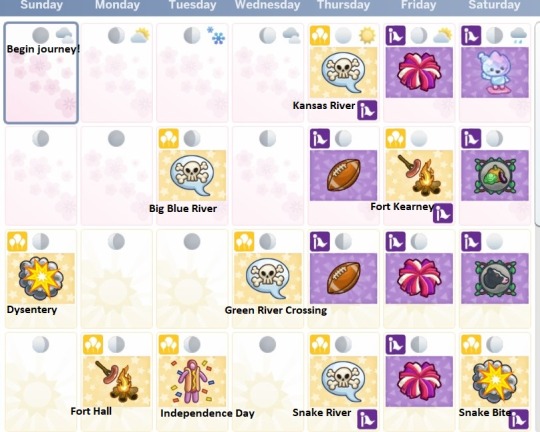
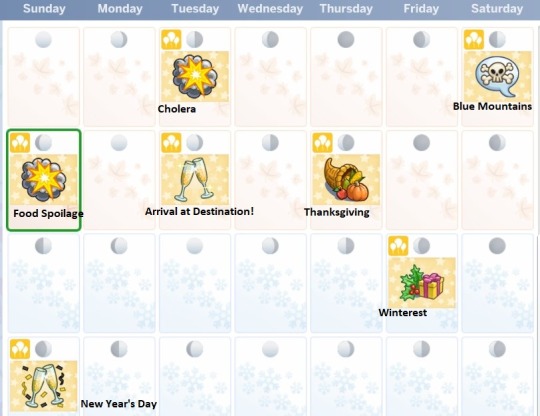
Optional: If you’d like to further simulate pioneers journeying across the country, you can move your pioneer sim household to wagon camps in different worlds with each river/mountain crossing. If you’re using my save file, use the numbered wagon train lots as listed below.
Recommended worlds to use:
Kansas/Big Blue River Crossings - #1 stay on original lot in Willow Creek
Green River Crossing - #2 Henford
Snake River Crossing - #3 Oasis Springs
Blue Mountains Crossing - #4 Copperdale
Homesteads:
In order to qualify for a homestead, sims must gain 4 skill points in 3 different skills (Baking, Cooking, Cross Stitch, Fishing, Fitness, Flower Arranging, Gardening, Gourmet Cooking, Guitar, Handiness, Herbalism, Horse Riding, Juice Fizzing, Knitting, Nectar Making, Painting, Piano, Pipe Organ, Violin, Writing) as well as meet the qualifications for homesteads below:
Basic Homestead: all skills obtained, $100 starting fund, 10 household wares
2 Bedroom Homestead: all skills obtained, $200 starting fund, 12 household wares
3 Bedroom Homestead: all skills obtained, $300 starting fund, 20 household wares
Middle Class Homestead: all skills obtained, $400 starting fund, 30 household wares
If sims decide to marry, they must each obtain the skills individually but can pool household wares and money to qualify for a homestead.
Since work is not allowed for the pioneers until they move out, they will need to grow and sell produce or create and sell crafted items to earn money. Items can be sold through their inventory for ease if desired. If using Chestnut Ridge as their town, items can also be sold at the General Store.
Household wares include what they rolled from earlier based on their socioeconomic backgrounds as well as anything they create while in the host house.
Note: if you choose to play with the Simple Living lot challenge turned on, you will also want your sims to bring some produce, canned goods, and possibly seeds with them to their homestead.
Once in their own homesteads, they can expand as they have funds and need or can move to a new lot.
Optional: When two homesteads have been established, you can build a Trading Post. This is where your sims can sell their wares through the sales tables available in Sims 4. A grocery stall from Cottage Living may also be placed. They can also sell items at the General Store in Chestnut Ridge.
If you prefer a lot from the Gallery, I highly recommend Old Western Township built by antiqueplumbobs (antiquated plumbobs : Western Township - Simblreen Gift #1 A CC-Free... (tumblr.com) It is perfect as a community lot for this challenge.
When all pioneer sims from the initial wagon have moved into their own homesteads, a second wagon of pioneers can be created and start their journey. As your initial sims have families of their own, you may choose to create families to journey to your town rather than individual sims. The second (and any future) wagon train households created will be played in rotation with the homestead households established by your original pioneers.
Careers:
Once on their own established homesteads, your sims can begin careers.
At home careers: farmer, orchard owner, florist, woodworker, dairy farm, llama farm, chicken farm, horse breeder, goat herder, sheep farmer, nectar maker, juice fizzer, herbalist
Careers in game: fisherman, manual laborer, gardener, painter, politician, writer, lawyer, doctor, teacher, criminal, entertainer (Note: I would suggest creating a specific sim to be the doctor to unlock medicine, creating a teacher to be part of a wagon train once your town begins to have infants/toddlers, etc - add the careers as it makes sense for your town, as most making this journey initially would have been farmers).
Optional careers:
Create a clergyman to perform marriage ceremonies among the settlers. Can add a fee to their household funds for each marriage performed, etc.
Add in custom careers, such as Fur Trader ( Peebs : Fur Trade Career | Original Career This career... (tumblr.com) )
That’s it! See how far your town can grow and advance as new settlers arrive but most importantly, have fun!
PDF link to rules
299 notes
·
View notes
Text
Oh I had some YU-NO thoughts cache'd I never shared. Thought #1: Btw YU-NO is a 1996 eroge time travel PC-98 VN, context I guess.
Anyway, so in visual novels you often have two goals: fuck multiple hotties and tell an engaging story. These goals are synergistic when your love interests are the story; you choose a girl, and your learn about her and date her and have relationship drama. That is one type of VN, but its not all types - every genre is present in the dating sim VN world, mystery & sci-fi/fantasy plots most commonly.
Here you start running into an issue; you want multiple romance routes, but you don't want to just repeat the story each time you date them. Most people will play multiple or even all the routes. But its not like you are going to write five different endings to your mystery plot. And you can't just...fuck all of them on the way to the ending as one cohesive story, because you are pathetic coward of a dev team and also a nation. A common answer to this dilemma (I first experienced it in G-senjou No Maou) is for you to have a "main" girl, whose romance arc is the plot arc. And then the other girls are clear side girls, who are involved in the main story, sure, and who will give you tidbits, of course, but at a certain point in your arc with them you just trail off. You forget about the murder mystery or whatever, you just date them, have sex scenes, and you will even sometimes have an epilogue where you remark "man, whatever happened with that crazy shit back then?" Its a bit of an odd genre convention but you can see how it works, its lets you have new content and date all the girls without ruining the story, you know who is the 'main' girl is after all.
YU-NO is a mystery sci-game, and it a quantum multiverse/timelines mystery game. You go through the story, and you collect objects along that story, and you also get jewels that let you anchor your spot in the worldline and teleport back to them with your inventory intact. It looks insane btw:

You get no in-game explanation of it at all, the idea of playing this without a guide seems like a cursed no-sleep streaming challenge.
But anyway, this opens up an interesting idea to you as a designer. You are intentionally supposed to hop back and forth in time, to collect items, and unlock the true ending. So why not build all the romance route storylines around that time travel? And put items at the end of each of those romance arcs? Now you can date them all! In fact, you have to! There is a perfectly logical, in-universe reason for why you have 5 different romance arcs; they are happening in different timelines. You date girl one first, then skip back in time, and start on the next - the main character only barely remembers the time skips, to him he doesn't even feel like he is cheating. Pretty sure its intentionally written that way to make that plot conceit work.
I'm sure other games have done similar tricks, but I think YU-NO is the first - it is a pioneer in VN space for using the high-concept quantum timeline stuff, that is its claim to fame. Its a cute little trick, I like it a lot.
90 notes
·
View notes
Text
World's Most Powerful Business Leaders: Insights from Visionaries Across the Globe
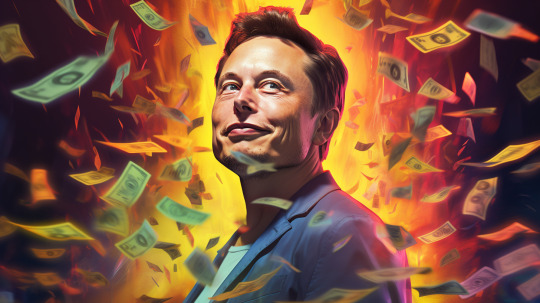
In the fast-evolving world of business and innovation, visionary leadership has become the cornerstone of driving global progress. Recently, Fortune magazine recognized the world's most powerful business leaders, acknowledging their transformative influence on industries, economies, and societies.
Among these extraordinary figures, Elon Musk emerged as the most powerful business leader, symbolizing the future of technological and entrepreneurial excellence.

Elon Musk: The Game-Changer
Elon Musk, the CEO of Tesla, SpaceX, and X (formerly Twitter), has redefined innovation with his futuristic endeavors. From pioneering electric vehicles at Tesla to envisioning Mars colonization with SpaceX, Musk's revolutionary ideas continue to shape industries. Recognized as the most powerful business leader by Fortune, his ventures stand as a testament to what relentless ambition and innovation can achieve. Digital Fraud and Cybercrime: India Blocks 59,000 WhatsApp Accounts and 6.7 Lakh SIM Cards Also Read This....
Musk's influence extends beyond his corporate achievements. As a driver of artificial intelligence and space exploration, he inspires the next generation of leaders to push boundaries. His leadership exemplifies the power of daring to dream big and executing with precision.

Mukesh Ambani: The Indian Powerhouse
Mukesh Ambani, the chairman of Reliance Industries, represents the epitome of Indian business success. Ranked among the top 15 most powerful business leaders globally, Ambani has spearheaded transformative projects in telecommunications, retail, and energy, reshaping India's economic landscape. His relentless focus on innovation, particularly with Reliance Jio, has revolutionized the digital ecosystem in India.
Under his leadership, Reliance Industries has expanded its global footprint, setting new benchmarks in business growth and sustainability. Ambani’s vision reflects the critical role of emerging economies in shaping the global business narrative.

Defining Powerful Leadership
The criteria for identifying powerful business leaders are multifaceted. According to Fortune, leaders were evaluated based on six key metrics:
Business Scale: The size and impact of their ventures on a global level.
Innovation: Their ability to pioneer advancements that redefine industries.
Influence: How effectively they inspire others and create a lasting impact.
Trajectory: The journey of their career and the milestones achieved.
Business Health: Metrics like profitability, liquidity, and operational efficiency.
Global Impact: Their contribution to society and how their leadership addresses global challenges.
Elon Musk and Mukesh Ambani exemplify these qualities, demonstrating how strategic vision and innovative execution can create monumental change.

Other Global Icons in Leadership
The list of the world's most powerful business leaders features numerous iconic personalities, each excelling in their respective domains:
Satya Nadella (Microsoft): A transformative leader who has repositioned Microsoft as a cloud-computing leader, emphasizing customer-centric innovation.
Sundar Pichai (Alphabet/Google): A driving force behind Google’s expansion into artificial intelligence, cloud computing, and global digital services.
Jensen Huang (NVIDIA): The architect of the AI revolution, whose GPUs have become indispensable in AI-driven industries.
Tim Cook (Apple): Building on Steve Jobs' legacy, Cook has solidified Apple as a leader in innovation and user-centric design.
These leaders have shown that their influence isn’t confined to financial success alone; it extends to creating a better future for the world.
Leadership in Action: Driving Innovation and Progress
One common thread unites these leaders—their ability to drive innovation. For example:
Mary Barra (General Motors) is transforming the auto industry with her push toward electric vehicles, ensuring a sustainable future.
Sam Altman (OpenAI) leads advancements in artificial intelligence, shaping ethical AI practices with groundbreaking models like ChatGPT.
These visionaries have proven that impactful leadership is about staying ahead of trends, embracing challenges, and delivering solutions that inspire change.
The Indian Connection: Rising Global Influence
Apart from Mukesh Ambani, Indian-origin leaders such as Sundar Pichai and Satya Nadella have earned global recognition. Their ability to bridge cultural boundaries and lead multinational corporations demonstrates the increasing prominence of Indian talent on the world stage.

Conclusion
From technological advancements to economic transformation, these powerful business leaders are shaping the future of our world. Elon Musk and Mukesh Ambani stand at the forefront, representing the limitless potential of visionary leadership. As industries continue to evolve, their impact serves as a beacon for aspiring leaders worldwide.
This era of leadership emphasizes not only achieving success but also leveraging it to create meaningful change. In the words of Elon Musk: "When something is important enough, you do it even if the odds are not in your favor." Rajkot Job Update
#elon musk#mukesh ambani#x platform#spacex#tesla#satya nadella#sundar pichai#jensen huang#rajkot#our rajkot#Rajkot Job#Rajkot Job Vacancy#job vacancy#it jobs
8 notes
·
View notes
Note
This may be an odd ask but are their any dark, gothic or horror games that inspire you/you've enjoyed? If not, what genres or sub genres/topics of literature would you like explore?
howdy! not a strange ask at all. it's a pretty fair question since my main areas of writing are dark and horror. the more gothic additions I've done are a recent exploration for me.
game-wise, here are some I've played that have left a lasting impression:
strange horticulture is a good cozy, gothic collection game with super natural themes!
wylde flowers is a cozy, witchy farm-sim and story-driven game that isn't inherently gothic, but the small town vibe still hits pretty good. good story. not really dark or horror.
the cosmic wheel sisterhood is another witchy game, not gothic, but it definitely falls into a sort of surreal, supernatural theme and is highly fascinating to play. exceptionally gay.
wytchwood is very witchy, more medieval than gothic. It has some dark and horror elements. I am like 95% sure the protagonist is baba yaga, which makes me happy considering I have the baba yaga house on chicken feet tatted on my arm lmaooo
amnesia: the dark descent fits into dark and horror, not necessarily gothic but close enough. the game has had its day, but it still stands as a massive pioneer in the horror genre.
amnesia: a machine for pigs fits into dark, horror, and gothic, but its timeline is placed at the turn of the century (1899). while considered a "horror survival", it is significantly story driven and probably has one of the best storylines and narrations I've read/heard in a long time.
and, ofc, you have the good old RPG maker games which have seen adaptations and remakes since when I played them years ago:
mad father, the witch's house, IB, yume nikki, misao, the crooked man, LISA, alicemare, OFF
just to name some. several of those come with massive trigger warnings tho, so look out for yourself.
as for genres/sub-genres I'd like to explore, I'd really like to try my hand at something as complex and visceral as cosmic horror. it's hard to explain, but cosmic horror that I've seen done right have these insane layers of intricacy to them, and it really evokes these...... deeply unnerving, innate feelings from inside of you. it's the type of writing that reaches in deep, but you're not sure what it's reaching, what it's touching, nor why.
I don't think I'm quite at that level as a writer yet, but it's definitely something I'd like to attempt in the future!
another subgenre I'll be exploring at some point soon is neo-western; post modern society with futuristic elements without being space-western. the story I plan to do will probably end up being the biggest to date, but that's some ways down the line
7 notes
·
View notes
Text
Extra Possible Entry For @cawthorntales Rose BC: Gon Dro

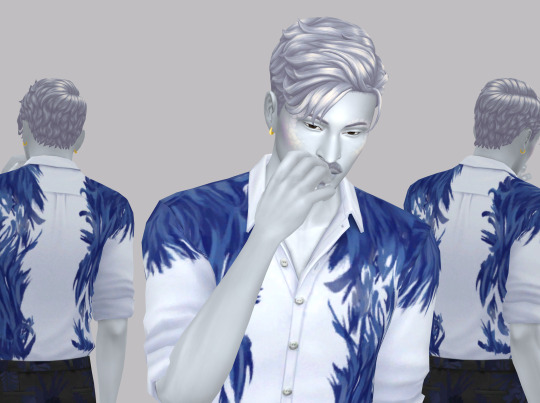


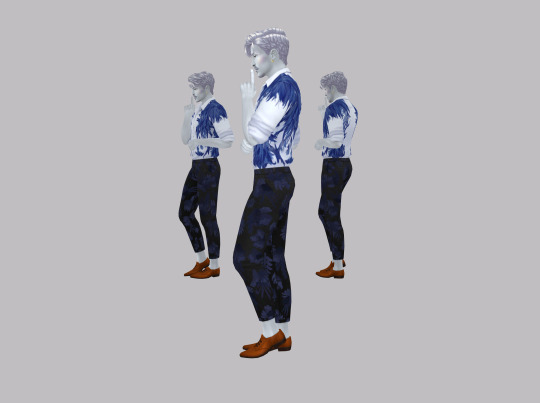
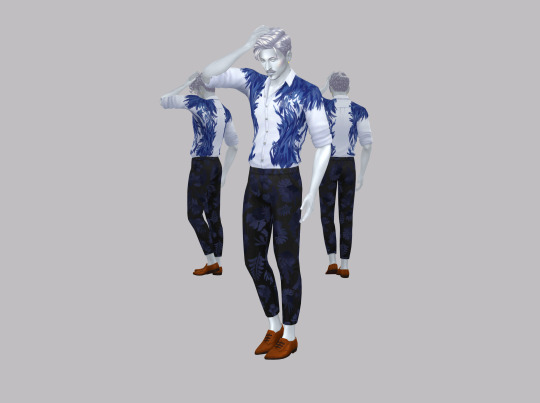
....
Name: Gon Dro
Age: Young Adult
Aspiration: Business Magnate
Traits: Flirty, Perfectionist, Bro
...

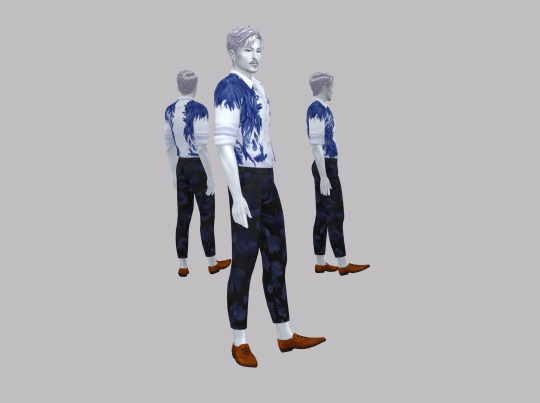
Born to a pair of seasoned Galactic Privateers, Gon Dro's childhood was more speedy getaways than playgrounds. As exciting as the chaos was to him, his parents had one too many close shaves to keep him with them guilt-free. So, at 10 years old, they sent him to live with his aunt and uncle back on SimWorld to keep him safe. It was clear that he'd inherited his parents' salesman-savvy nature when he was trading textbooks for candy in elementary. Luckily, his new guardians nurtured his entrepreneurship in a more legal direction, and when he was old enough, he majored in Business at Britechester College. (To this day, he still gets care packages from his parents, equipped with his father's signature space biscuits.)

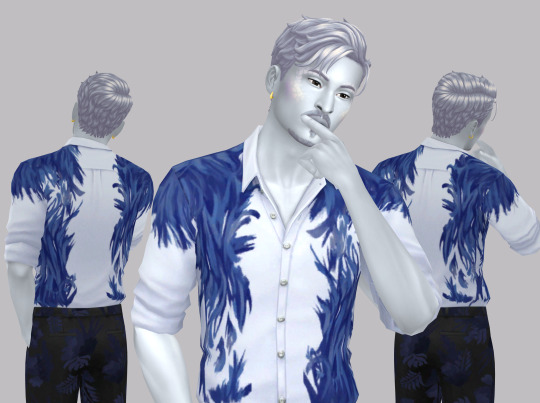
Now, Gon Dro runs a business of his own. You've probably never heard of it. "Gadgets and Gizmos." 😏 Where the galactic meets the antique. Different items from all over the galaxy are bought, sold, traded, or repaired. Some are worth a couple simoleons with a bit of sprucing up; others are valued in the thousands. It's the perfect place for the techie AND the casual consumer. As the only gizmo-thrift-store of its kind, Gon has taken a niche and gradually made himself the pioneer.
Through word of mouth and a mysterious social media marketing campaign, G&G is growing in popularity, and so is its creator. But just like his business, Gon Dro is an outlier. An outsider. Charming a room of sims can only distract him form his loneliness for so long. And the few flings he's had only left him lonelier.
So he's here. On a bachelor challenge where everyone can see him possibly fall flat on his face, after years of cultivating a cool, suave, mysterious image. Because what he wants most in this world is someone to share his world with.
Could Rose be that someone?

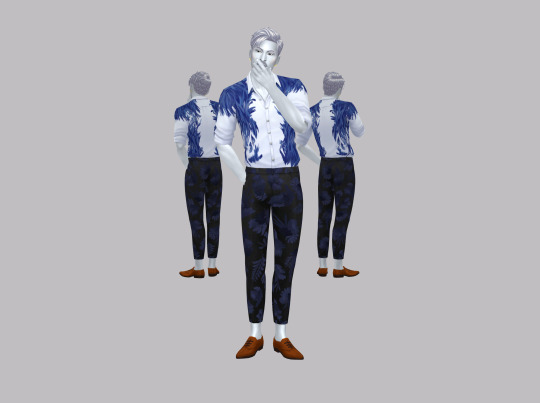
#sims 4#the sims 4#sims4#simblr#n0bodysims#sims4cas#the gardenia bc#sims 4 bachelor challenge#ts4 bachelor challenge#BC Hopefuls#BC Challenge
8 notes
·
View notes
Text
Challenge Name: "Celestial Legacy Challenge"
Objective: Lead an alien family through generations, each with unique goals that explore their extraterrestrial roots and integrate into the human world.
**Generation 1: The Alien Arrival**
- Goal: Introduce the first alien to the Sim world, with the aspiration to blend in seamlessly.
- Aspiration: "Stranger in a Strange Land"
- Traits: Loves the Outdoors, Genius, Friendly
- Legacy Goal: Establish a human identity, complete with a successful career and social relationships.
**Generation 2: The Interstellar Diplomat**
- Goal: Develop diplomatic skills, build connections with both aliens and humans, and maintain a balance between the two worlds.
- Aspiration: "Interstellar Ambassador"
- Traits: Charismatic, Good, Social Butterfly
- Legacy Goal: Host a successful interstellar peace summit or negotiation event.
**Generation 3: The Hybrid Heir**
- Goal: Form a romantic relationship with a human, resulting in the birth of the first alien-human hybrid.
- Aspiration: "Celestial Union"
- Traits: Ambitious, Artistic, Family-Oriented
- Legacy Goal: Raise the hybrid child to embrace both their alien and human heritage.
**Generation 4: The Galactic Explorer**
- Goal: Embrace the family's alien origins by exploring the cosmos, discovering new planets, and collecting extraterrestrial artifacts.
- Aspiration: "Space Explorer"
- Traits: Adventurous, Geek, Perfectionist
- Legacy Goal: Create a dedicated space-themed room with collected artifacts.
**Generation 5: The Alien Scientist**
- Goal: Pursue a career in science, focusing on alien-related research, and unlock advanced technological knowledge.
- Aspiration: "Scientific Pioneer"
- Traits: Genius, Perceptive, Ambitious
- Legacy Goal: Develop and display groundbreaking alien technology.
**Generation 6: The Telepathic Connection**
- Goal: Master psychic abilities and establish a telepathic connection within the family, fostering a unique bond.
- Aspiration: "Psychic Link"
- Traits: Good, Neurotic, Supernatural Fan
- Legacy Goal: Achieve a high level of psychic power and maintain a harmonious telepathic connection.
**Generation 7: The Celestial Guardian**
- Goal: Assume the role of a guardian, either protecting the alien world or ensuring the family's legacy remains strong for future generations.
- Aspiration: "Celestial Guardian"
- Traits: Brave, Family-Oriented, Disciplined
- Legacy Goal: Achieve a high level of success in chosen career while preserving the family's unique heritage.
Guide your alien family through these generations, balancing their celestial origins with their integration into the human world, leaving a lasting legacy that spans the stars.
12 notes
·
View notes
Text
System Shock
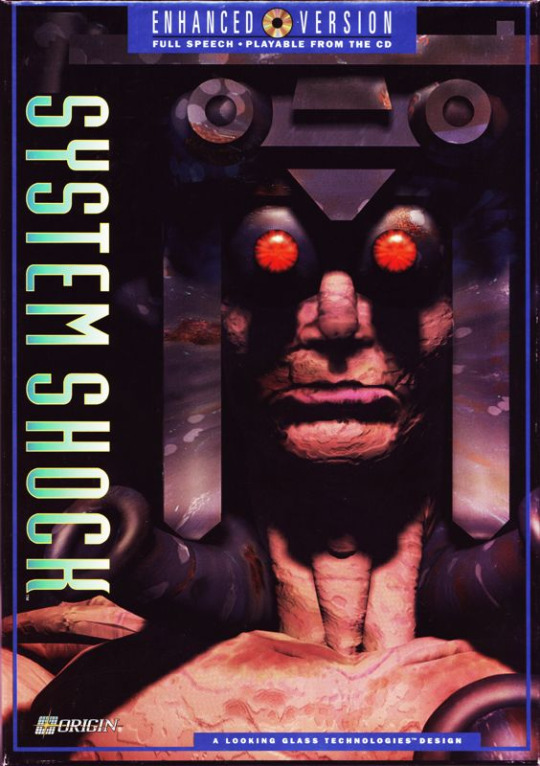
The original System Shock, developed by Looking Glass Studios and released in 1994 is a classic game. It’s a hard to categorize game, especially at the time. At its core it’s a first-person-shooter, but it got elements of a puzzle-adventure game with an emphasis on exploration that reminds me of the metroidvania genre. It just recently in 2023 it got a full-fledged remake from the studio Nightdive, but let’s talk about the original DOS version.
And I did play the original DOS version. Nightdive released an “Enhanced Edition” that runs in modern Windows with improvements such as mouselook, but I had difficulties getting that game’s MIDI music to run on my Linux box. So I got the DOS “classic edition” from GOG and ran it in dosbox, complete with the original control scheme.
The game had an unusual elaborate plot for an action game at the time. It’s a proper cyberpunk-sci-fi story, set in the year 2072. The premise is explained in the intro cutscene. The player character is a computer hacker, who tries to hack into the systems of the Trioptimum megacorp, but gets caught within minutes. A corporate executive named Edward Diego does however offer the hacker a way out and gives him a job offer. The corporation owns a space station in a orbit around Saturn, named Citadel Station, controlled by the AI Shodan. If the hacker goes to Citadel, and hacks into Shodan and removes her ethical constraints, his charges will be dropped and he will be repayed with a “military-grade” neural implant. The hacker accepts and does the job for Diego.
The hacker gets put into a medical coma on Citadel to recover from the neural implant surgery. And when he wakes up six months later, you take control and begin the game. It’s here where System Shock reveals itself to be quite innovative in game storytelling. The intro, death and ending cutscenes are the only traditional cutscenes you get in this game. Instead this game’s story is told through exploration from an unbroken first-person perspective, four years before Half-Life.
There aren’t even the dialogue trees you had in rpgs and adventure games of the time. And that’s because once you wake up on Citadel Station, you’ll quickly find that pretty much everyone is dead, or will be when by the time you get to them. And the whole game takes place on Citadel Station. There is a lot of gore in this game, as you find dismembered bodies everywhere. Your character slept through a disaster.
Shodan has of course rebelled against humanity, and is turning Citadel’s research technology against her creators. She has aspirations to godhood, and wants to remake life to her own liking. Shodan has therefore turned humans into mindless mutants with bioweapons, or converted them into her cyborg slaves, or created pure metal robots. And she is aiming the station’s mining laser against earth cities and unleashing her bioweapons upon what’s left after that. To be fair to Shodan and her hubris, being able to design and create life and rain death from the heavens is pretty god-like. You of course has to stop her and save humanity.
The way you piece together this is by exploring and finding audio logs left behind by humans and even Shodan, scattered across the station. You also get voiced e-mails from people monitoring the situation back on Earth, and Shodan sends some threatening ones herself. This is a system of storytelling that is almost cliché nowadays but which System Shock pioneered back in 1994. And it’s very well implemented here. It’s a way of storytelling that is built around exploration, you find the story by exploring and you can keep exploring while you listen to the audio.
System Shock is usually seen as the progenitor of the genre of “immersive sim” and immersive it is.
The feeling of exploring the aftermath of a disaster, putting together what happened and how to fix it piece by piece is very compelling. It helps that you don’t have traditional objective system telling you what to do, instead you have to figure it out by listening carefully to all these audio logs.
The story isn’t original or that complex. But the way it’s told makes it actually engaging, because you have to piece it together yourself. And Shodan is such a great villain. Her writing and the voice acting of Terri Brosius, distorted through clever sound editing, is excellent and rightfully iconic and influential. Glados in the Portal gamestakes a lot from Shodan.
The level design is also built around exploration.. There are multiple levels of Citadel Station, and there is progression from one level to the next, but you can return to previous levels, and in fact the game requires you to backtrack at certain points. The levels are built so you can explore somewhat non-linearly. The game is in many ways a first-person metroidvania, where you explore a large interconnected map, filling in your own automap, finding tools and abilities as you go along, enabling you to explore further by accessing areas you couldn’t before.
Thanks to the neuroimplant, the hacker has access to various cybernetic hardware that give him superhuman abilities. So you can get a lantern installed to navigate dark areas, an envirosuit to resist bio contamination and radiation, a booster to run faster, and most importantly to access new areas, jetboots to float and fly. Your abilities drain electricity, which is their main limitation. You have to literally recharge your batteries to keep on using them, from Citadel’s power stations or portable batteries you can find. It’s a neat gameplay feature that give some power fantasy kicks without feeling too overpowered.
The immersion is helped by how the level design aspires to far greater realism than was common in non-adventure games at the time. Most game levels were pretty abstract and served often no purpose but to challenge the player. The mazes with monsters of Doom is a good example. Now the levels of System Shock are probably too maze-like for complete realism, but there is a clear sense that the game environments serve a in-universe purpose. Each level of Citadel station had a purpose for the people who once used it, there is a medical floor, a research floor, a maintenance floor, to name only the first three. And every texture in the game has a name that will appear if you click on it, which often explains its purpose.

And part of why Shodan is such a great villain is that she is literally integrated into the levels. Citadel Station is her body, she is the mind of the station, and you feel that she is omnipresent throughout the game. And she has turned it against you and has in fact already killed all the other humans within. She is watching you from her security cameras, and knows what you are doing. Shodan sometimes sends messages directly to you, mocking and threatening you. But she is still a presence even when she isn’t as direct. All the enemies and obstacles you face is her doing. Her image sometimes appears on computer screens randomly, probably just to freak you out.
And beyond sending enemies at you and setting traps, Shodan directly locks doors that prevent your progress. A major gameplay element is lowering Shodan’s control over each level, so that she can no longer block those doors. And you do that by smashing the security cameras and blowing up Shodan’s computer nodes, lowering the level’s “security level.” And once it’s gone or low enough, doors Shodan once locked can be opened.
It’s a major part of progressing through the game. Shodan calls the player character an insect, and playing the game you do feel like a computer bug she has, small and insignificant but messing up her plans and functioning. You are like the literal bug found in Harvard Mark II that may have caused the term computer bug to be coined. Or like a rat chewing at Shodan’s wires.
Now this immersive storytelling is partially possible because System Shock was such a technologically innovative game.
System Shock’s engine was a technical marvel at the time, because it was an engine for a first-person shooter with full-fledged, actual 3D. The back cover calls it “the gaming world's first true 3-D simulation.” Doom had come out the year before, but it was a kind of fake 3D, where “room over room” multi-level structures are not possible. System Shock’s producer Warren Spector actually coined the term “2.5D” in a contemporary interview to describe his games competitors like Doom.
And Spector was right to brag a bit, System Shock engine seems ahead of its time. We take it for granted today that if for example you have a bridge in a 3D game you can both walk on it and under it, but being able to do so in System Shock was impressive in 1994. The only thing not fully 3D is that enemies and objects are 2D sprites but it’s well-implemented.
The full 3D engine allows for a pretty much unprecedented freedom of movement compared to games at the time. You can look up and down, you can lean and look around corners, you can crouch and go prone to get into tight spaces. Nowadays this is standard, but in 1994 revolutionary. Being able to go vent-crawling or taking shots from cover by leaning around a corner was really new. Gordon Freeman learned to vent-crawl from the System Shock hacker.
The control system does shows its age though. There is no mouselook. Instead you control the camera entirely with the keyboard, you press R to look up, F to center your view, and V to look down. You can’t rebind the keys in the original DOS version, which also means you are stuck with ASDX for movement (A=forward, A and D= turn left and right, X= backward, and Z and C to strafe left and right). This game came before WASD became the standard, although interestingly it uses Q and E for the lean function, leaving W as the only letter key in that part of the keyboard without a movement binding.

The game also came with one of the largest and most elaborate HUDs to ever grace a first-person-shooter. Instead of mouselook, you can move the cursor into the HUD to operate it. The HUD is actually quite useful once you understand how it works, it’s how you use your cybernetic abilities, but getting that understanding is the difficulty
The movement system is definitely useable, but it’s awkward. The controls and HUD have been compared to playing an operating system. There have been a lot of fanmade ports like System Shock Portable and Shockolate, the official Enhanced Edition and the recent remake, all to fix the original game’s control scheme by adding mouselook and WASD controls.
Still, you can become accustomed to and proficient at the original control scheme if you put the effort in, I did. It is in fact like learning a new OS, but that’s doable.
And even if you don’t become proficient, you can adjust the difficulty. And System Shock’s difficulty settings are unique. You can adjust the difficulty on different game elements, combat, puzzles, plot and cyberspace, independently of each other. You can make this into essentially a point-and-click adventure game by turning puzzles difficulty up and combat difficulty all the way down. Or a pure run-and-gun shooter by turning up combat and removing plot and puzzle difficulty. It’s such a flexible system that you can turnSystem Shockinto a clone of Beneath a Steel Sky or Doom depending on your tastes.It’s a great difficulty system where each player can create a game challenge suited to their tastes.
Even the combat has an interesting and forgiving mechanism: the restoration bays. They are medical machines, one per every level of the station, that can revive people from near-death. Shodan however has converted them into machines that turn people into her cyborg slaves. But thanks to the work of another resistance member, you can flip a switch on each level to turn the machines back into revival machines. When you die on a level where you flipped the switch on the machine, Shodan’s robots will drag you to the machine to turn you into a cyborg, but the machine revives you instead. So you can die on that level without any serious penalty once that switch is flipped. If you die before that switch is flipped, you get a game-over cutscene of being turned into a cyborg. You have to find the machine and its switch on each level before you are safe.
I played it as an adventure game, where the only dangers were environmental hazards. But I could tell that the gunplay in this game is satisfying if you play it as a shooter, despite the awkward controls. The lean system allows you to take cover, and there is a rich variety of guns with satisfying animations and noises, and the death animations of the enemies are also enjoyable.
I do recommend turning the cyberspace difficulty all the way down. It’s probably the most splashy, but also the most awkward to actually play gameplay element of System Shock. It’s essentially a minigame where you use your neural implant to hack computer systems. And the way the game portrays this is you flying around a flashing wireframe environment running into floating blocks and shooting things at enemies. You have full free 3d movement, like the Descent series.It looks cool, but the controls are awkward and floaty. And it’s a pain to navigate the wireframes. And the developers clearly knew that, since they put gigantic arrows pointing you in the right direction. I have no regrets about making enemies non-aggressive and having a generous timelimit to it.
The fact that the final boss battle against Shodan takes place in cyberspace is part of why it disappoints. Going into cyberspace to navigate an annoying wireframe maze to find Shodan’s cyberspace avatar and shoot at it until it dies is such a disappointing ending. After a whole game where the player has been fighting Shodan in more indirect and more interesting ways, just shooting at her cone form until she dies is not that engaging. The ending cutscene essentially is just a joke too.
Still, if the ending is disappointing, it’s because it’s very hard to end such a great game satisfactory. This is a hard game to describe, because the gameplay and storytelling mechanics are so complex and varied, which is why this review is a bit rambling. There is so much to talk about, and it’s all interconnected. It’s a game that allows for such freedom in how it is played that the player is given the tools to make their own game, make their own way through Citadel station. It’s such an intelligently designed immersive experience that is remarkably advanced for 1994. And it has one of the greatest villains in all of video games. Hail SHODAN.
5 notes
·
View notes
Text

𝐓ɦ𝖾 𝐋𝗒𝗋α𐓣𝗌, 𝗍ɦ𝖾 𝐕𝖾𝗀α𐓣𝗌 & 𝐀ρ𝖾𝗑 𝐏ᥣα𐓣𝖾𝗍 🌀
The Vegans were the first ones to develop identifying themselves as a non-Lyran species. Vega is a star in the constellation of Lyra. In fact, a movement started to grow stronger (especially during the space exploration). This group wasn’t interested in following the expansive and pioneering flow of Lyra. Sim hey wished to focus more inward. They did a lot of spiritual practices and all that required them to gain strength and eventual go back to Source. So it was in hopes of being reunited again, that a group decided on a new set of rules and philosophies. As Lyra demonstrated to be of service to others (expansion) , Vega demonstrated to be of service to self (contraction). Needless to say, conflicts started in the vicinity of Lyra. Neither one of them was open to an integrative way but wanted to know who was right or wrong, good or bad. Polarization just continued to grow.
Meanwhile, a third civilization manifested: the Apex planet. It was a common place for both positive and negative traits. It began by integrating the qualities of Lyra and of Vega. Genetically, they were a bigger mix than Earth. Eventually, polarity took over and allowed pollution and weaponry to take over . It can be an example for Earth as a possible path might be taken. The Apex planet destroyed it self due to nuclear war. Some of its people went hiding underground to survive. As a result of the nuclear explosion, they catapulted the planet to an alternate dimension.
As for Lyrans and Vegans, but all were supportive of the wars and decided to removed themselves from the conflicts. A way of escaping was to escape from their planet and find news areas to colonize. Vegans did this with Altair and Centauri and Sirius and Lyrans with Pleiades.
4 notes
·
View notes
Text
I am finally free. A whole month of playing The Sims 3 again for the first time in literal years. Enjoyed it a lot. But now it's time for me to move on.
The Traveling Witch and The Pioneer of Plumbotics
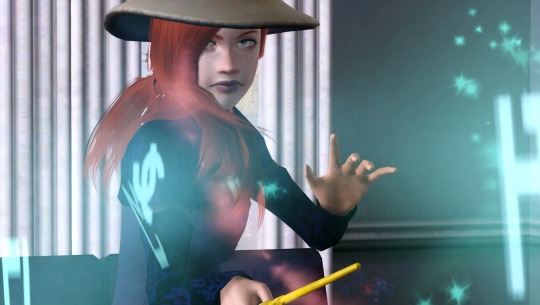
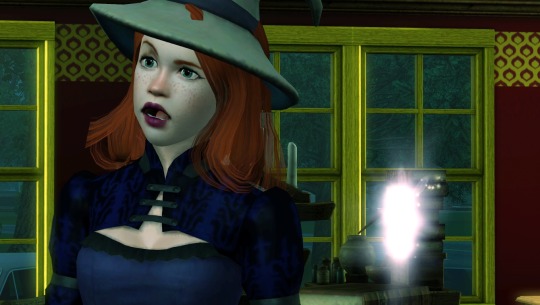
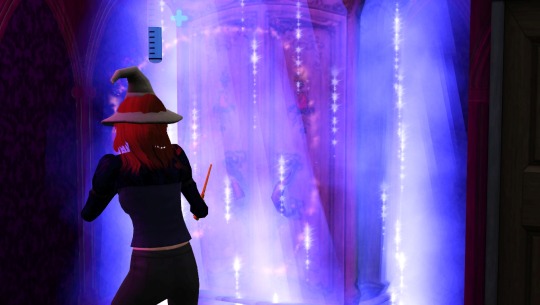
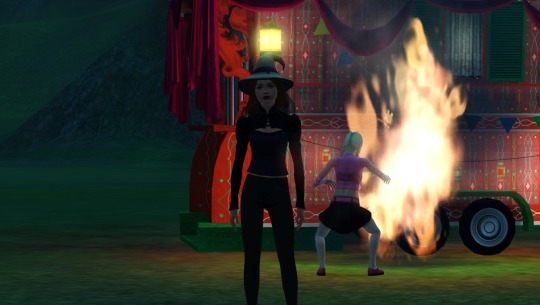
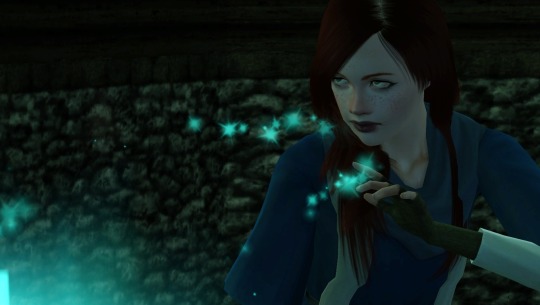
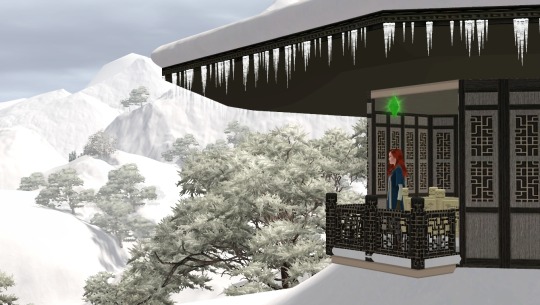


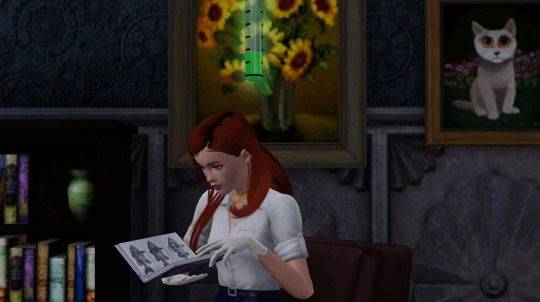
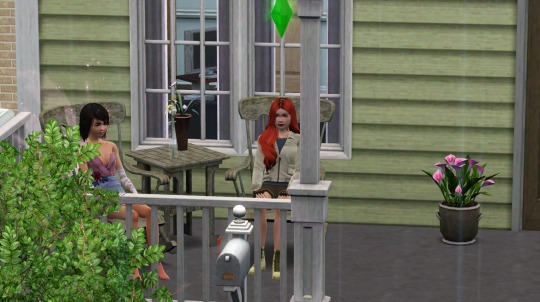
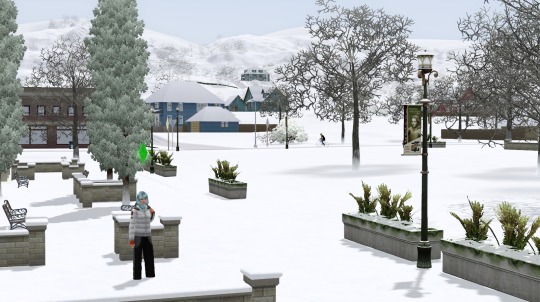

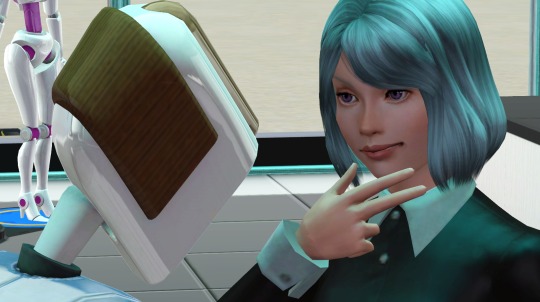

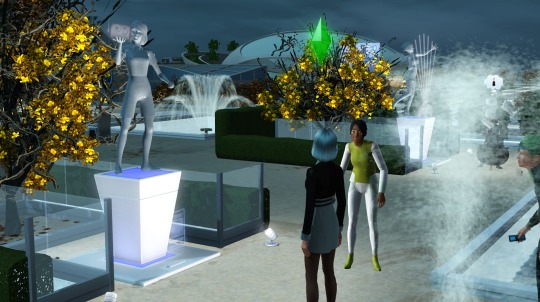
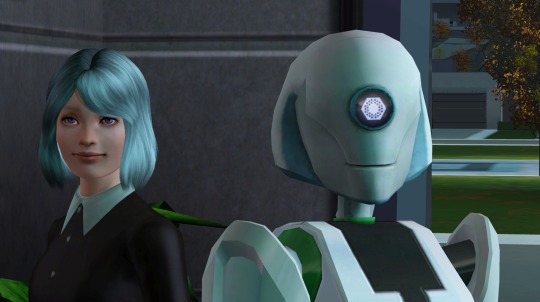
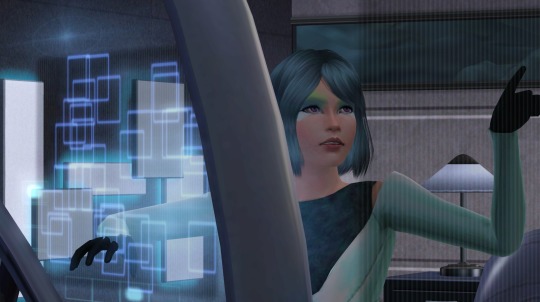
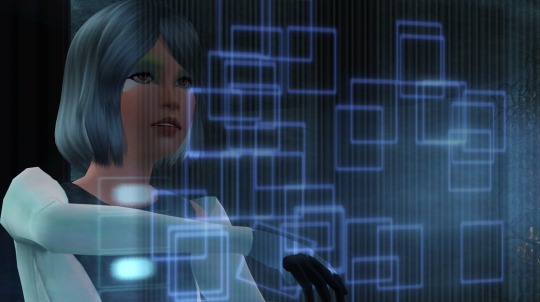
I'm going to miss them, but I've done everything I've wanted to. For now, I'm just glad I'll have some more space on my computer lol.
#maybe I'll try a legacy challenge one day#one day when I'll have a better pc with a lot more space#ts3#the sims 3#the sims 3 into the future#the sime 3 supernatural#the sims 3 world adventures#simblr#still a much better game than sims 4#I'M FREEEEEEEEEEEEEEEEEEEEEEEEE
4 notes
·
View notes
Text
The Evolution and Impact of Online Gaming Sites

Online gaming has seen an unprecedented surge in popularity over the past two decades. From humble beginnings in text-based games to the vibrant, immersive worlds of today, online gaming sites have become a central part of modern entertainment. These platforms have not only transformed the way we play games but also how we socialize, compete, and connect with others worldwide.
For More Information Visit: Satta King
# The Rise of Online Gaming
The journey of online gaming began with basic multiplayer games on local networks in the 1970s and 1980s. As internet technology advanced, the 1990s saw the emergence of online games accessible via dial-up connections. Titles like "Ultima Online" and "EverQuest" were pioneers in the massively multiplayer online role-playing game (MMORPG) genre, allowing thousands of players to interact in expansive virtual worlds.
The 2000s marked a significant turning point with the advent of broadband internet, making online gaming more accessible and seamless. Games like "World of Warcraft," launched in 2004, became cultural phenomena, attracting millions of players and setting new standards for online interaction and content delivery.
# The Diversity of Online Gaming Sites
Today, online gaming sites cater to a diverse range of preferences and gaming styles. Here are some key categories:
1. **MMORPGs and Virtual Worlds**: These platforms, like "World of Warcraft" and "Final Fantasy XIV," offer rich narratives and complex gameplay. Players can create avatars, join guilds, and embark on epic quests, forming deep social bonds and communities.
2. **First-Person Shooters (FPS)**: Games like "Call of Duty" and "Counter-Strike" dominate this genre, emphasizing fast-paced action and competitive play. Online FPS platforms often host tournaments and leagues, contributing to the rise of esports.
3. **Battle Royale**: Titles such as "Fortnite" and "PUBG" have popularized the battle royale format, where players compete in large-scale, last-man-standing matches. These games are known for their dynamic gameplay and frequent updates.
4. **Strategy and Simulation**: Games like "StarCraft II" and "The Sims Online" cater to players who enjoy strategic thinking and long-term planning. These sites often include intricate systems for resource management and tactical decision-making.
5. **Casual and Mobile Games**: Platforms offering games like "Candy Crush" and "Clash of Clans" have tapped into the casual gaming market. These games are designed for short, engaging play sessions and are accessible on various devices.
# Social and Cultural Impact
Online gaming sites have redefined social interactions. They provide spaces where people from different backgrounds can come together, collaborate, and compete. Friendships and communities formed in these virtual environments often extend beyond the game, leading to real-world meetups and social networks.
The rise of streaming platforms like Twitch has further amplified the impact of online gaming. Gamers can now broadcast their gameplay to global audiences, turning gaming into a form of interactive entertainment. Influencers and content creators play a crucial role in shaping gaming trends and promoting new titles.
# The Esports Revolution
One of the most significant developments in online gaming is the emergence of esports. Professional gaming has evolved into a lucrative industry, with players competing in international tournaments for substantial prize pools. Games like "League of Legends," "Dota 2," and "Overwatch" are at the forefront of this movement, drawing millions of viewers to live events and online streams.
Esports organizations, sponsorship deals, and dedicated training facilities underscore the professional nature of competitive gaming. This shift has not only legitimized gaming as a career but also brought it into mainstream media.
# Challenges and Future Directions
Despite its growth, online gaming faces several challenges. Issues like cyberbullying, addiction, and data privacy are ongoing concerns. Game developers and platform operators must continue to innovate in creating safe and inclusive environments for all players.
Looking ahead, advancements in technology such as virtual reality (VR) and augmented reality (AR) promise to further revolutionize online gaming. These technologies offer immersive experiences that blur the line between the virtual and real worlds, potentially creating entirely new genres and ways of playing.
# Conclusion
Online gaming sites have come a long way from their early days, evolving into multifaceted platforms that entertain, connect, and inspire millions. As technology continues to advance and the gaming community grows, these sites will undoubtedly play an even more significant role in shaping the future of entertainment and social interaction. Whether through competitive esports, casual mobile games, or immersive virtual worlds, the influence of online gaming is here to stay, continually transforming the digital landscape.
0 notes
Text
MSI Created MS-C903 Intel Tiger Lake-UP3 AI Ready PC Box

Unveiling the MS-C903, a flexible embedded system engineered to satisfy the exacting demands of several industries such as robotics, automation, gaming, transportation, and medical, is MSI, a prominent pioneer in technology solutions.
Some of the MS-C903’s primary features are:
Durability and Reliability: The platform’s stability and dependability are guaranteed by a number of facility
The MS-C903 is designed to function dependably at temperatures between -20 and 70°C. It is engineered to perform well in demanding circumstances. Consistent power supply is ensured by its wide voltage DC input (12~24V) and overvoltage and overcurrent protection (OCP and OVP). Hardware monitoring using an Infineon TPM Controller (SLB9670VQ2.0/FW7.85) and a 256-level watchdog timer are two examples of enhanced security capabilities. Its shockproof and vibration-reducing construction guarantees longevity and complies with IEC 61373.
Flexible installation is provided by the MS-C903’s several mounting choices, which include wall mount, DIN rail, and VESA mount. Furthermore, its superior performance, propelled by the Intel 11th Gen Tiger Lake-UP3 Embedded/Industrial SKU Series and a multitude of I/O ports, renders it perfect for a wide range of applications.
High-performance platform based on Intel X-86
Enables the effortless connection of various devices by supporting a number of I/O interfaces. Appropriate for many uses in the business.
Intel Tiger Lake-UP3
The Intel 11th Gen Tiger Lake-UP3 Embedded/Industrial SKU Series powers the MS-C903, which is a powerful computer that offers excellent performance. Up to 64GB DDR4 3200 MHz SODIMM memory support improves multitasking, and a variety of graphics solutions, from Intel Iris Xe Graphics (for i5/i7 SKU) to Intel UHD Graphics (for i3 SKU), meet a range of demands. The MS-C903 offers smooth communication for a variety of applications because to its several I/O interfaces, which include dual display support, audio, USB, serial, GPIO, CANbus, and two RJ-45 ports.
Big Expansion: Offer M.2 as a more compact, dependable, quick, adaptable, and scalable storage and networking solution.
The MS-C903 is a small, high-speed storage and networking solution that offers M.2 and enhances flexibility and performance. It also boasts extensive expansion potential. The system effectively meets a variety of application requirements by allowing for space-constrained designs and multi-expansion for SSD storage through its three M.2 slots, which enable different key types (M, B, and E).
AI Compliant
Demonstrating an intelligent 360-degree remote real-time patrolling system through the use of the Intel OpenVINO AI development toolkit and MS-C903, which can help you deploy solutions more quickly than ever before and satisfy a variety of applications that call for high-performance and low-power computing kernels, like image processing technology. Smart city, smart factory, and AIoT gateway applications can benefit greatly from the flexibility that the AI Box PC provides to machine builders and system integrators in building systems.
Applications like gaming, automation, robotics, medical (with reliable, fanless operation), transportation (compatible with IEC 61373), and gaming (supporting LAN and USB connectivity) are all well suited for the MS-C903. The MS-C903 is an embedded systems technology leader with a strong design, outstanding performance, and substantial expansion capabilities.
MSI MS-C903 Features
Compact-Size Box PC with Intel Tiger Lake-UP3 Processor for Ultra Low-Power Fanless Solution
Intel 11th Gen Tiger Lake-UP3 Embedded/Industrial SKU Series
2 DDR4 3200 MHz SODIMM Slots up to 64GB
Dual independent displays: DP++ , HDMI
2 2.5GbE LAN with RJ-45
1 M.2 B key (with NANO SIM-holder) support 5G/LTE, 1 M.2 E key
1 M.2 M key, 1 SATA 3.0 for storage (2.5” SSD)
4 USB 3.2 Gen 2, 4 USB 2.0, 4 COM (4 RS-485), 2 COM or 1 CANbus (Option by M.2 Module), DIO, Audio
Onboard TPM 2.0
6 opening reserved for antennas
Anti-Vibration & Shockproof Design to Compliance IEC 61373
Wide operating temperature: -20~70°C
Wide Voltage DC-IN 12~24V (OCP & OVP)
Ultra-Compact with fanless design
In relation to MSI IPC
Reputed for its quality and stability, MSI is one of the top 3 motherboard manufacturers in the world, having designed and manufactured motherboards for more than 30 years. With dependable, scalable products that provide long-term support, MSI has been entering the embedded and industrial industries since 2006. Premium embedded boards and systems from MSI serve a wide range of uses, such as industrial automation, gaming, utility, digital signage, digital signage, digital signage, ATMs, POS systems, kiosks, and transportation. MSI is a leading global provider of Design and Manufacturing Services (DMS) solutions, with strong R&D and manufacturing skills. This positions the company as a preferred partner in the embedded and industrial industry.
Read more on govindhtech.com
#msi#memory#USB#gaming#SSDStorage#DDR4#Motherboard#MS-C903#news#technews#technology#technologynews#govindhtech
0 notes
Text
Join the Meeps in World Turtles v1.0 full release

World Turtles launches v1.0 city builder colony sim game on Linux, Steam Deck, Mac, and Windows PC. Thanks to the dedication and talent of the team at Re: cOg Mission, we have this cosmic adventure. Available on Steam, GOG, and Humble Store. Well, it's here. Now you can dive into a universe teeming with adventure and responsibility. In World Turtles 1.0, you're not just playing a game – you're launching into a journey of cosmic proportions on Linux and Steam Deck. A colossal space reptile, the World Turtle, cruising through the stars with entire civilizations perched upon its shell. But this majestic creature also needs our help to survive, and that's where you come in. As a result, you'll join forces with the Meeps, a clan of peace-loving beings. Due to launch into a mission to save the World Turtle and the worlds it carries. It's not about domination; it's about collaboration. Together, pioneering a new era of cooperation and innovation in the cosmos. But it won't be easy. You'll also face treacherous stretches of space and the possibility of encountering other World Turtles. Diplomacy will be crucial as you navigate through unknown territories and establish alliances.
World Turtles launches 1.0 Release Date Announcement
youtube
Now, let's talk features. Prepare to take control and customize your Reeves – trusty companions on your journey. Explore countless diplomatic avenues as you interact with other civilizations. Due to travel in style, launching Space Pods, your ticket to exploring space and discovering other World Turtles. But this isn't just about exploration; it's about sustenance. Since players need to feed the World Turtle, nurture it as it carries you through the cosmos. It's a delicate balance between survival and harmony with the natural order of the universe. So, grab your Space Pod, rally your allies, and get ready for an epic adventure where the fate of worlds hangs in the balance. World Turtles is not just a game launch – it's a testament to the power of unity and the resilience of the human spirit. Embark on this extraordinary journey, where cooperation reigns supreme and the cosmos await our exploration. Due to answer the call of the Turtle and become a legend among the stars. If you decide to buy the game, why not drop an honest review on Steam? Your thoughts and experiences can make a huge difference for indie dev's. Plus, spreading the word to friends, or even your social media can help others discover their next big adventure. It's amazing how a simple share or chat can also lead to new discoveries in the indie gaming world. World Turtles 1.0 launches this city builder colony sim on Linux, Steam Deck (playable), Mac, and Windows PC via Steam (discounted 30%), GOG, and Humble Store. Priced for $19.99 USD / £16.75 / 19,99€. Don't miss your chance to be part of something truly cosmic. Join our community on Discord and follow us on Twitter/X.
#world turtles#city builder#colony sim#linux#gaming news#re: cog mission#ubuntu#mac#windows#pc#steam deck#unity#Youtube
0 notes
Text
Three decades after UN milestone, experts convene to find AI climate solutions - Technology Org
New Post has been published on https://thedigitalinsider.com/three-decades-after-un-milestone-experts-convene-to-find-ai-climate-solutions-technology-org/
Three decades after UN milestone, experts convene to find AI climate solutions - Technology Org
Thirty years after a United Nations convention combating climate change entered into force, the dangers of increasing human-caused, planet-warming emissions are on full display. Severe droughts strain water reserves, surging temperatures threaten food supplies and rising sea levels turn whole villages into climate refugees. Scientists warn it will get much worse.
UC Berkeley scholars work in the Yaghi Lab on February 14. Image credit: Kayla Sim / UC Berkeley College of Computing, Data Science, and Society
But climate change isn’t the only phenomenon that’s accelerating. The science and technology needed to address its impacts is also rapidly advancing. Using the power of artificial intelligence, material and climate science experts are developing cutting-edge technology to stem the planet’s warming and its related impacts. They are converting water molecules from the air into drinking water, making clearer and faster climate and weather predictions and building better renewable energy systems.
“This space is really growing,” said Aditi Krishnapriyan, a UC Berkeley College of Chemistry assistant professor in chemical engineering and member of the Bakar Institute of Digital Materials for the Planet (BIDMaP). “We’re in an age where we can advance science with machine learning methods, while also leveraging a lot of new insights in developing these methods.”
“This is a really fruitful area that has a lot of potential to have a big impact on the world,” said Krishnapriyan. Her research uses machine learning, physics and chemistry to solve renewable energy, climate and drug discovery problems.
That growth and possibility will be evident this month at the AI and Physical Sciences for Climate Innovation Symposium. Starting March 26, the two-day event will convene some of the world’s leading climate and computing experts and academics, like Krishnapriyan, to learn from and engage with one another about the future of this field.
The event is organized by BIDMaP and Climate Change AI (CCAI), organizations aimed at pioneering and harnessing artificial intelligence to combat the climate crisis. It will take place in-person in Sutardja Dai Hall in Berkeley, Calif., and will be available for viewing via livestream.
“I’m hopeful that this event will lead to greater discourse between communities that don’t often find occasions to talk together,” said David Rolnick, co-founder and chair of CCAI and a speaker at the event.
“There’s been a surge of interest in this area within both academia and increasingly the private sector. It’s seen as a time of great innovation and growth,” said Rolnick, a McGill University assistant professor in computer science. “There is potential for having a significant impact upon a field that’s young enough to be malleable and mature enough to be impactful.”
Using AI and physical sciences to address climate change
Experts at the symposium will speak about how they are using artificial intelligence to develop materials. Aionics Chief Executive Officer Austin Sendek, whose startup discovers and brings to market new materials for energy and climate solutions, will speak on a panel about how the next phase of this work could be influenced by big data and large language models.
The event will also highlight how AI can speed up scientific discoveries in labs and how AI is being used to understand and estimate future weather and climate. Rolnick and Animashree Anandkumar, a computing and mathematical sciences professor at the California Institute of Technology, are keynote speakers.
The agenda is stacked with industry and academic trailblazers like Rolnick, Sendek and Krishnapriyan.
Berkeley College of Computing, Data Science, and Society Dean Jennifer Chayes, BIDMaP Co-Director Christian Borgs, BIDMaP Co-Director and College of Chemistry Professor Omar Yaghi, and Meta Fundamental AI Research Team Research Director Larry Zitnick are just some of the other influential speakers at the event. William Collins, laboratory director of the Earth and Environmental Sciences Area at Lawrence Berkeley National Laboratory and professor in Berkeley’s Department of Earth and Planetary Science, is another well recognized speaker and participant.
A UC Berkeley scholar works in the Yaghi Lab in Berkeley, Calif. Image credit: Kayla Sim / UC Berkeley College of Computing, Data Science, and Society
New research directions and partnerships – fast
These kinds of gatherings often lead to new research partnerships and directions, Rolnick said. They are especially important in this moment, said Sendek. AI technology is advancing rapidly. The planet is warming fast. And developing new hardware and materials to apply to the climate crisis can take decades and billions of dollars.
This symposium and similar events allow pioneering experts to quickly “align on the ground truth of what’s happening” and make strategic decisions, Sendek said. Scientists have said we have until 2050 to cut our greenhouse gas emissions in half. With a growing population, that’s not much time, he said.
“Clearly there is exponential acceleration happening in two fields. One is in computing power. The other is in AI,” said Sendek, who is also an adjunct professor at Stanford University. “If we can chain the rate of progress in hardware, materials, batteries and other devices to those exponentials, we can do this. If we’re going to continue at the same sort of linear rate of progress of the past, we’re probably going to fall short.”
Krishnapriyan, who is also an assistant professor in the Department of Electrical Engineering and Computer Sciences, hoped the symposium would be motivating for students who attended, showing them the possibilities of this field. There are opportunities to use machine learning to do interdisciplinary, unique and impactful work, she said.
“This is an exciting time to get into this space,” she said.
Source: UC Berkeley
You can offer your link to a page which is relevant to the topic of this post.
#A.I. & Neural Networks news#ai#air#artificial#Artificial Intelligence#artificial intelligence (AI)#batteries#Big Data#Building#change#chemical#Chemical engineering#chemistry#climate#climate change#climate crisis#climate science#college#computer#Computer Science#computing#cutting#data#data science#devices#Discoveries#display#drinking#drinking water#drug
0 notes
Text
Global Femtocell Market Analysis 2024 – Estimated Market Size And Key Drivers
The Femtocell Global Market Report 2024 by The Business Research Company provides market overview across 60+ geographies in the seven regions - Asia-Pacific, Western Europe, Eastern Europe, North America, South America, the Middle East, and Africa, encompassing 27 major global industries. The report presents a comprehensive analysis over a ten-year historic period (2010-2021) and extends its insights into a ten-year forecast period (2023-2033).
Learn More On The Femtocell Market: https://www.thebusinessresearchcompany.com/report/femtocell-global-market-report
According to The Business Research Company’s Femtocell Global Market Report 2024, The femtocell market size has grown rapidly in recent years. It will grow from $5.56 billion in 2023 to $6.63 billion in 2024 at a compound annual growth rate (CAGR) of 19.3%. The growth in the historic period can be attributed to smart home initiatives, cost efficiency improvement, regulatory support and standards, early iot pioneers, enterprise deployment..
The femtocell market size is expected to see rapid growth in the next few years. It will grow to $13.69 billion in 2028 at a compound annual growth rate (CAGR) of 19.9%. The growth in the forecast period can be attributed to rapid urbanization, expanding mobile data usage, remote work culture, small cell integration, cloud and virtualization adoption.. Major trends in the forecast period include 5g network rollout, iot and smart devices, remote work and telecommuting..
Increasing applications of the smartphone have propelled the growth of the femtocells market. A smartphone is a type of portable device that integrates a mobile phone and a computer into one device. Smartphones are used for value-added services such as voice and data, software, video conferencing, music downloads, and online games. The femtocell works with a cellular network provider to improve cellular portable mobile devices, particularly in areas where coverage by cellular systems utilising big cells is patchy and inconclusive. For instance, in April 2021, according to the survey of smartphone ownership commissioned by a nonpartisan American think tank, the Pew Research Center, the share of Americans that own a smartphone increased from 81% in February 2019 to 85% in February 2021, which was just 35% a decade ago (in 2011). In addition, in 2021, according to the India Brand Equity Foundation (IBEF), the Indian smartphone market observed a 10-fold expansion from 14.5 million smartphone shipments in 2011 to 150 million in 2020. Thus, increased the growth of the smartphone usage for valuable services and network technology such as 4G are boosting femtocell demand.
Get A Free Sample Of The Report (Includes Graphs And Tables): https://www.thebusinessresearchcompany.com/sample.aspx?id=8269&type=smp
The femtocell market covered in this report is segmented –
1) By Type: 2G Femtocell, 3G Femtocell, 4G Femtocell, 5G Femtocell 2) By Technology: IU-H, IMS/SIP 3) By End-User: Residential, Commercial, Public Space
Technological advancement is a key trend gaining popularity in the femtocells market. Companies are releasing new innovations, integrating their products with the Internet of Things (IoT), using distributed antenna systems and cloud radio access networks (C-RAN), and investing in small-cell infrastructure to strengthen their position in the market. For instance, in May 2021, Nokia, a Finnish multinational telecommunication, information technology, and consumer electronics corporation, introduced its smart node femtocell all-in-one solution, which would successfully densify networks and provide an excellent customer experience in constrained indoor spaces. It aids traffic control by reducing core network load and enhancing macro resource allocation. It combines uncongested high throughput network performance with currently utilized secure authentication to give a secure connection and SIM-based authentication to ensure the quality required in mobile networks.
The femtocell market report table of contents includes:
Executive Summary
Market Characteristics
Market Trends And Strategies
Impact Of COVID-19
Market Size And Growth
Segmentation
Regional And Country Analysis . . .
Competitive Landscape And Company Profiles
Key Mergers And Acquisitions
Future Outlook and Potential Analysis
Contact Us: The Business Research Company Europe: +44 207 1930 708 Asia: +91 88972 63534 Americas: +1 315 623 0293 Email: [email protected]
Follow Us On: LinkedIn: https://in.linkedin.com/company/the-business-research-company Twitter: https://twitter.com/tbrc_info Facebook: https://www.facebook.com/TheBusinessResearchCompany YouTube: https://www.youtube.com/channel/UC24_fI0rV8cR5DxlCpgmyFQ Blog: https://blog.tbrc.info/ Healthcare Blog: https://healthcareresearchreports.com/ Global Market Model: https://www.thebusinessresearchcompany.com/global-market-model
0 notes
Text
16.5.-24.5.:
Dienstag: Heute sind Mama und Papa angekommen, so gegen 18 Uhr. Ich hab vorher noch ein Projekt für Computer Vision fertig gemacht. So um 17 Uhr war ich dann am Flughafen, da musste ich dann noch ein bisschen warten wegen der Immigration aber es hat nicht allzu lange gedauert. War echt schön die Beiden nochmal zu sehen. Wir sind dann direkt zu mir gefahren, besonders fit war ich damals nach meinem Flug von Frankfurt ja auch nicht mehr. Abends haben wir noch Salat gegessen und sonst nichts mehr gemacht.
Mittwoch: Zuerst sind wir in die Innenstadt zur Space Needle und so, wir waren auch in den Chihuli Gardens aber nicht auf der Needle. Dann sind wir zur Uni, das ist ja das absolute Highlight von Seattle. Wir waren fast den ganzen Tag unterwegs. Abends gab es wieder Salat, diesmal mit Hähnchenbrust.
Donnerstag: Heute zuerst Golden Gardens Park, dann Gas Works Park. Danach waren wir noch eine SIM Karte für Papas Handy kaufen und dann sind wir bis zum Pioneer Square runtergelaufen. Da waren dann wie immer viele Obdachlose also sind wir nur noch auf den Columbia Tower und dann zurück nach Hause.
Freitag: Heute ging es dann los nach Vancouver Island. Die Fähre ist um 8 Uhr gefahren und war um 11 ungefähr in Victoria. Wir haben dann direkt das Auto abgeholt, war echt groß und schön. Dann ging es direkt los Richtung Norden. Auf dem Weg haben wir ein paar Mal angehalten, da gibt es ja überall schön Ecken. Das Ziel für heute war Port Alberni. Kurz davor gab es zwei sehr schöne State Parks mit Wasserfällen, da haben wir jeweils einen kurzen Spaziergang gemacht. Um kurz vor 7 waren wir dann im AirBnB. Dort gab es auch direkt leckeres Abendessen und dann hab ich den Rest des Abends auf dem Balkon mit extrem guter Aussicht gesessen.
Samstag: Heute weiter nach Tofino. Auf dem Weg gab es sehr viele schöne Stopps. Man ist da ja wirklich mitten in der Natur, da wohnen kaum Menschen in der Nähe außer halt in Tofino und Uclulet. Mein Highlight heute war der gigantische Sequoia den wir gesehen haben. Abeds waren wir in einem sehr leckeren Restaurant essen, Papa war sehr zufrieden.
Sonntag: Heute die Küste runter bis Uclulet. Auf dem Weg haben wir uns den Pacific Rim National Park angeschaut. Da gab es viele schöne Wanderungen, der Strand war riesig und echt viele Surfer. Highlight war aber der Rainforest Trail, da war man mitten im unberührten Wald und die haben da einen Steg gebaut auf dem man sozusagen über dem Wald läuft. Die Unterkunft heute war echt super, mit Kamin und Küche und allem. Wir haben abends dann Steak mit Salat gemacht.
Montag: Heute ging es zurück nach Victoria. Die Fahrt ist echt lang also haben wir nicht allzu oft angehalten aber trotzdem waren schöne Orte dabei. Zum Beispiel der Nordstrand von Vancouver Island, da musste man 1km bis zum Wasser laufen weil es so flach war (wie an der Nordsee). Abends waren wir Asiatisch essen in Victora, war sehr lecker.
Dienstag: Heute haben wir uns Victoria angeschaut. Die Stadt ist echt sehr schön, bis jetzt auf jeden Fall die schönste in Nordamerika. Schöne Häuser und nicht zu groß, also alles locker zu Fuß machbar. Wir waren nochmal Asiatisch Essen, diesmal in Chinatown. Da gab es so eine Suppe die echt lecker war, man musste da das rohe Fleisch selber in die Suppe machen, war interessant. Die Fähre zurück nach Seattle war dann um 7 Uhr Abends. Gab keine Probleme. Sind dann von der Fähre mit dem Uber zurück und dann ins Bett.
Mittwoch: Ich hab morgens Mama und Papa zur Bahn gebracht, jetzt geht es für die Beiden weiter nach Las Vegas und dann auf den Road Trip mit dem Wohnmobil. Ich bin dann an die Uni und hab nach ewiger Zeit nochmal was gemacht. Aber ich hab nicht viel zu tun, war nach ein paar Stunden fertig. Soichiro ist jetzt im Moment hier, echt schön ihn nochmal zu sehen. Abends waren wir im Finn´s, war wir immer viel zu voll. Beim rausgehen heute musste man sich richtig durchboxen.








0 notes